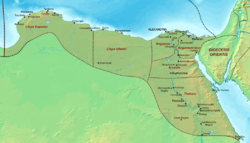Diocese of Egypt (Late Antiquity)
| Diocese of Egypt Dioecesis Aegypti Διοίκησις Αἰγύπτου |
|||||
| Diocese of the Byzantine Empire | |||||
|
|||||
| The Diocese of Egypt c. 400. | |||||
| Capital | Alexandria | ||||
| Historical era | Late Antiquity | ||||
| • | Separation from the Diocese of the East | ca. 381 | |||
| • | Diocese abolished by emperor Justinian I. | 539 | |||
| Today part of |
|
||||
The Diocese of Egypt (Latin: Dioecesis Aegypti, Greek: Διοίκησις Αἰγύπτου) was a diocese of the later Roman Empire (from 395 the Eastern Roman Empire), incorporating the provinces of Egypt and Cyrenaica. Its capital was at Alexandria, and its governor had the unique title of praefectus augustalis ("Augustal Prefect", of the rank vir spectabilis; previously the governor of the imperial 'crown domain' province Egypt) instead of the ordinary vicarius. The diocese was initially part of the Diocese of the East, but in ca. 380, it became a separate entity, which lasted until its territories were finally overrun by the Muslim conquest of Egypt in the 640s.
Egypt was formed into a separate diocese in about 381. According to the Notitia Dignitatum, which for the Eastern part of the Empire dates to ca. 401, the diocese came under a vicarius of the praetorian prefecture of the East, with the title of praefectus augustalis, and included six provinces:
Parallel to the civil administration, the Roman army in Egypt had been placed under a single general and military governor styled dux (dux Aegypti et Thebaidos utrarumque Libyarum) in the Tetrarchy. Shortly after the creation of Egypt as a separate diocese (between 384 and 391), the post evolved into the comes limitis Aegypti, who was directly responsible for Lower Egypt, while the subordinate dux Thebaidis was in charge of Upper Egypt (Thebais). In the middle of the 5th century, however, the latter was also promoted to the rank of comes (comes Thebaici limitis). The two officers were responsible for the limitanei (border garrison) troops stationed in the province, while until the time of Anastasius I the comitatenses field army came under the command of the magister militum per Orientem, and the palatini (guards) under the two magistri militum praesentales in Constantinople.
...
Wikipedia

